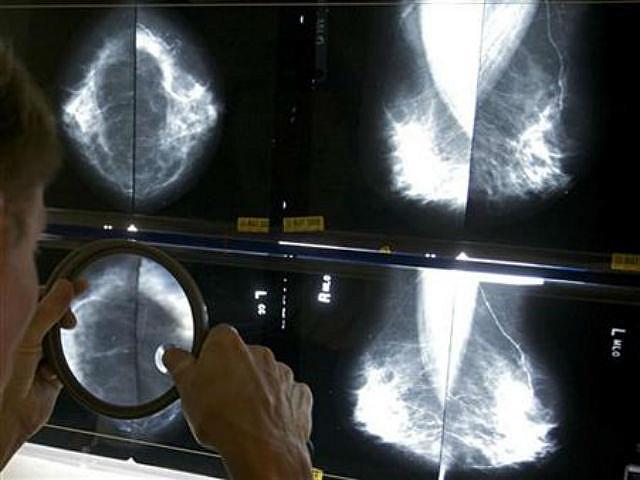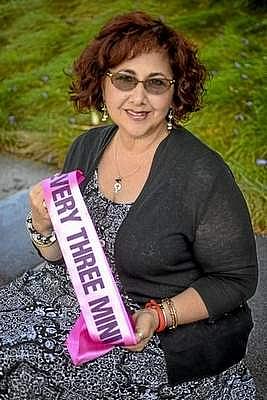Cancer screening debate heats up as doctors question federal government's motive
The U.S. Preventive Services Task Force comes under question by physicians as the group again prepares to release its final recommendations on breast cancer screenings. Physicians wonder if scaling back on screenings is a result of pressure from health insurers and the Affordable Care Act.

Photo by the Associated Press

The blood that seeped from Anush Avejic’s right breast became a lifesaving clue.
Avejic was a young mother of two with no history of breast cancer in her family. But suddenly the 34-year-old faced a mammogram, then treatment.
“I’m very thankful that that happened,” Avejic, now 57 and a resident of Sunland, said of the bleeding that led to her stage 1 diagnosis. “Had it not, my cancer would have gotten worse.”
Physicians are concerned about the women who have no such clues that lead them to mammograms. They say more women are becoming confused by federal guidelines that tell them that if they are not at risk and under 50, they don’t need mammograms or other cancer-prevention screenings.
“Medicine is changing drastically and physicians are no longer allowed to use clinical judgment,” said Dr. Peter Weiss, founder of the Rodeo Drive Women’s Health Center in Beverly Hills who also was the health care adviser to former New York Gov. David Paterson.
Weiss is referring to guidelines issued by the U.S. Preventive Services Task Force, an independent group of doctors and health care experts who make recommendations using evidence-based medicine to determine best practices for the public’s health and on screenings for everything from prostate cancer to osteoporosis. Last month, the task force released draft recommendations on mammograms for women that include letter grades beside each guideline. For example, they issued a “B” grade for mammograms every two years for women 50 to 74 years old but a “C” for mammography for women younger than 50.
Those recommendations are similar to the ones released in 2009, which came under criticism by some cancer groups. The updated guidelines are still under review.
Weiss and other physicians say aside from adding to the public’s confusion about preventive screening, the recommendations that receive “C” grades could lead to insurance companies dropping coverage of mammograms for women under 50.
Because of her history, Avejic, for example, urged her then-28-year-old daughter to have a mammogram, but the insurance company wouldn’t pay for it at first.
It’s hard not to question if the recommendations are a result of pressures under the Affordable Care Act, some physicians said.
“They are treating the masses as opposed to treating individuals,” Weiss said of the task force. “They claim to work on evidence-based medicine to make recommendations. It’s based on data they elect to look at. Data in and of itself is useless.”
In a column for the Washington Post, Dr. Kirsten Bibbins-Domingo, a vice chair of the U.S. Preventive Services Task Force, said the group made those recommendations based on “in-depth review of the strongest available science regarding mammography.”
“Our goal is to provide women and their primary care clinicians with unbiased, comprehensive recommendations so each woman can make an informed decision about what is right for her,” she wrote.
Bibbins-Domingo called mammograms a good test but not a perfect one. She said mammograms help women ages 40 to 74 lower their chance of dying from breast cancer, and the benefit for screening increases with age.
“But even with advances in technology, this benefit does not come without harms,” she wrote. “The most serious potential harm is being diagnosed with a cancer that would not become a threat to you during your lifetime. This is called ‘overdiagnosis,’ and it may result in women going through treatment for breast cancer unnecessarily. Another common potential harm is false-positive tests that can lead to unnecessary breast biopsies and can cause stress and anxiety.”
She advised women to speak to their physicians if they are concerned.
Similar reasons were made in 2012 for advising against tests for men who were at a low risk for prostate cancer.
The federal Centers for Disease Control and Prevention agrees with the U.S. Preventive Services Task Force on several of the group’s guidelines but also released a report last month that found that many U.S. adults are not getting the recommended screening tests for colorectal, breast and cervical cancers. Data for 2013 show that 58 percent of adults ages 50 to 75 years reported being screened for colorectal cancer, which is no better than in 2010 (71 percent is the target); 73 percent of women ages 50 to 74 had a mammogram, which was the same three years before (80 percent is the target); and 80 percent of women ages 21 to 65 had a Pap test, which was lower than in 2000 (93 percent is the target).
Dr. Juan Felix, an expert in gynecologic pathology and cytology at University of Southern California, said he understands physicians’ concerns with the fewer screenings but agreed with much of the task force’s recommendations. Yet he worries about cervical cancer.
In 2013, the task force issued recommendations for cervical cancer, saying that women between the ages of 21 and 29 should have a Pap test every three years. They should not be tested for human papillomavirus or HPV unless it is needed after an abnormal Pap result. Women between the ages of 30 and 65 should have both a Pap and an HPV test every five years.
His concern is with a new test developed by the pharmacology company Roche and approved by the Federal Drug Administration, which encourages physicians to do only HPV screening.
“I want to offer caution,” he said, adding that HPV testing alone missed more cancers. “The people who advocate HPV-only tests are looking at population expenditures.”
All of the guidelines and debates only bring confusion to a patient, said Dr. Reed Wilson, a cardiologist and president of Physicians Private Practice Advocate Group in Los Angeles.
“I thought that the greatest advances in medicine was our ability to personalize your care, because in other words, not everyone is the same,” Wilson said. “I’m trying to treat patients as individuals. All of a sudden, what’s best is to treat everybody as a population. I rarely have a population coming into my office.”
Avejic, who will once again participate in the upcoming Avon 39 walk in Santa Barbara, said she was diagnosed with breast cancer again, 18 years after the first diagnosis. She also is a colon cancer survivor.
“I have heard about the guidelines,” Avejic said. “I don’t think it should be a one size fits all. I know the mammography for 50 years and up is important but look at my case, and women who are younger. It’s something that should be available with advice and consultation.”

